Key takeaways:
- Prayer acts as a transformative space for reflection, clarity, and emotional connection, providing solace during difficult times.
- Exploration of religious texts, such as “The Power of a Praying Life” and “The Book of Common Prayer,” emphasizes prayer’s role in building a relationship with the divine and enhancing emotional well-being.
- Establishing a daily prayer practice can cultivate inner peace and provide a grounding routine that positively influences mindset.
- Incorporating mindfulness and variety into prayer practices enriches the experience, allowing for deeper connections with spirituality.
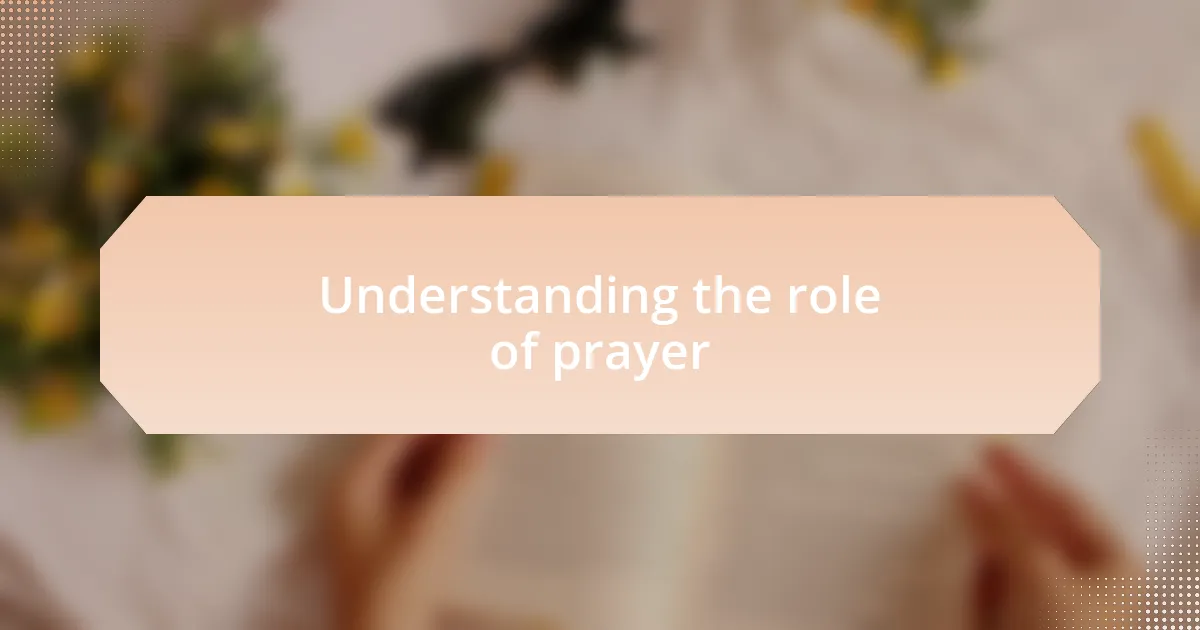
Understanding the role of prayer
Prayer serves as a bridge between our innermost thoughts and the divine. I remember a time when anxiety consumed me; it felt like I was drowning in uncertainty. In those moments, I would take a deep breath, close my eyes, and reach out in prayer, finding solace in the act of surrendering my worries.
There is something transformative about the ritual of prayer. It often feels like a warm embrace, especially during turbulent times. Have you ever experienced that moment when you articulate your fears and hopes as if they’re being heard? In my journey, I discovered that this exchange nourished my spirit, enabling me to tackle challenges with renewed strength.
When I pray, I also find clarity in my thoughts. It’s a time to reflect and listen, creating a dialogue with my own soul. Have you ever pondered how prayer can bridge the gap between confusion and understanding? For me, it’s a space where I gain insights that guide my decisions, illuminating paths I might have otherwise overlooked.
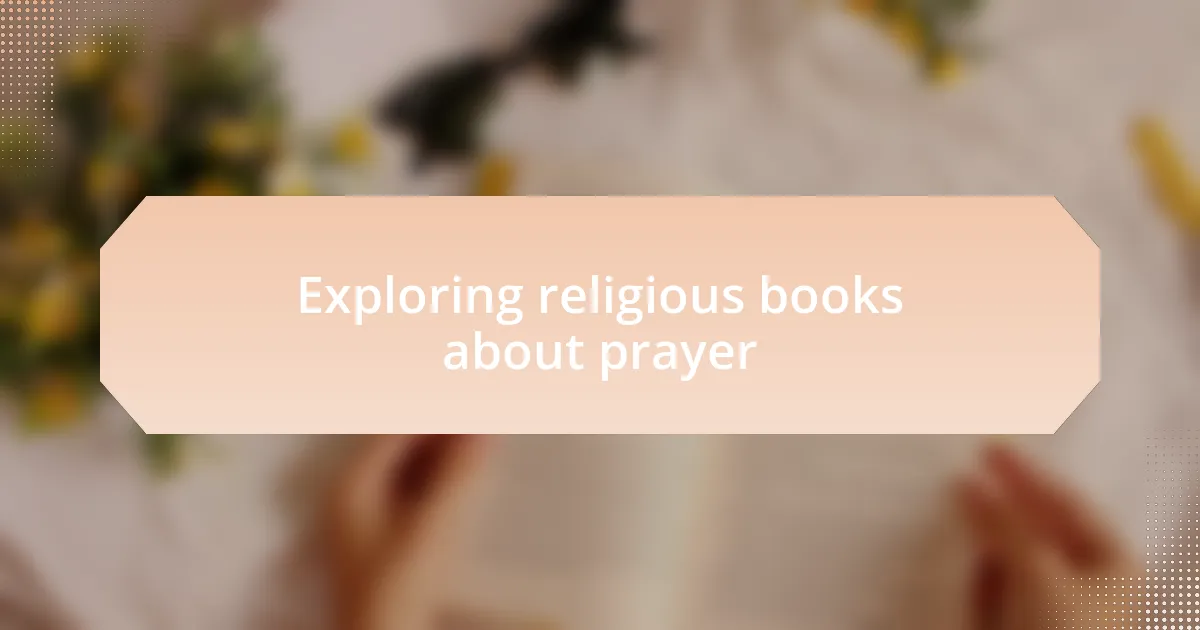
Exploring religious books about prayer
When exploring religious books about prayer, the depth of content can be truly enlightening. One book that stands out in my journey is “The Power of a Praying Life” by Stormie Omartian. Each chapter resonated deeply, as it highlighted how prayer can be a source of strength and guidance. Have you ever read something that shifted your perspective entirely? For me, this book showed me that prayer isn’t just about asking; it’s about developing a relationship and truly listening.
Another remarkable resource is “Prayer: Experiencing Awe and Intimacy with God” by Timothy Keller. I found this book particularly profound because it delves into the theology of prayer alongside practical insights. It made me reflect on the beauty of prayer as an act of intimacy rather than merely a ritual. Have you ever considered the emotional connections that form when you pray? This perspective transformed my understanding of how deeply prayer can affect our emotional well-being.
In my personal exploration, I discovered that “The Book of Common Prayer” offers a structured approach that supports daily conversations with the divine. I remember flipping through its pages during a challenging season, discovering prayers that echoed my own sentiments. Did you know that incorporating such structured prayers can sometimes help those who struggle with finding their own words? It taught me that even in routine, there can be profound moments of connection that gradually bring peace.
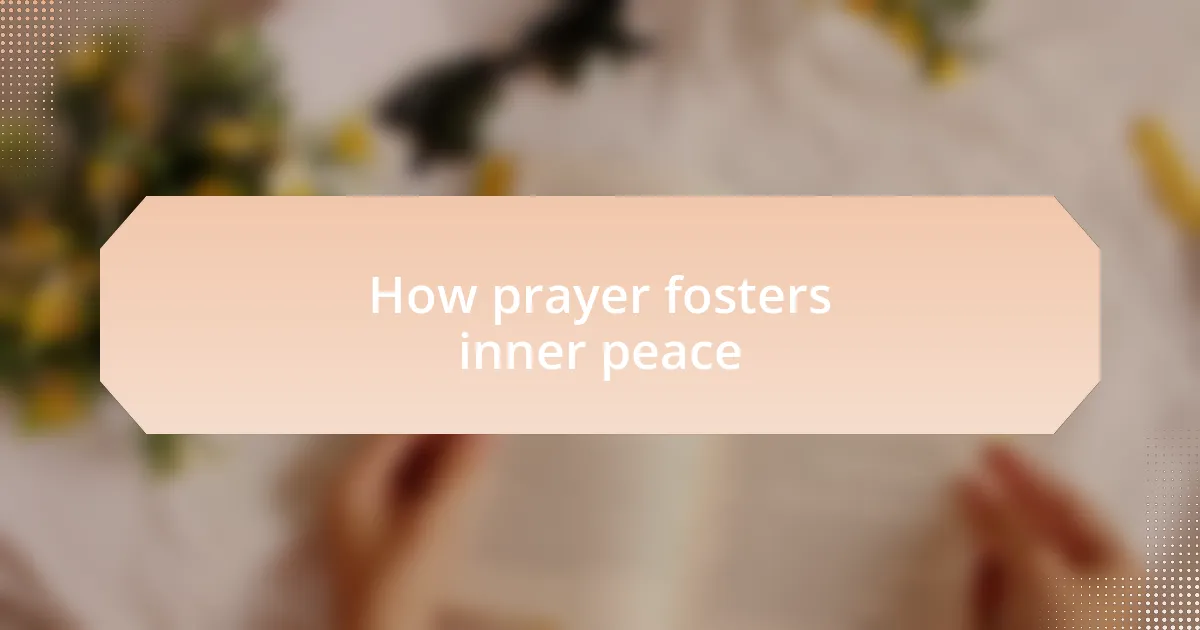
How prayer fosters inner peace
Prayer has a way of calming the chaotic thoughts that often swirl in my mind. I recall a particularly stressful period when I began setting aside a few minutes each morning to pray. During those moments, I felt a palpable sense of stillness wash over me, as if the distractions of the world faded into the background. Isn’t it interesting how a simple shift in focus can bring such a profound sense of serenity?
The rhythm of prayer can act as a grounding tool, anchoring me when life’s storms threaten to overwhelm. I remember a night of anxiety when I repeated a simple mantra throughout my prayers. With each repetition, I felt layers of tension releasing, replaced by an overwhelming sense of trust and hope. Have you ever experienced that moment when worries start to dissolve, leaving clarity in their wake? This is the essence of inner peace that prayer can cultivate.
Engaging in prayer often leads me to a deeper introspection, inviting me to confront my feelings honestly. I once discovered that, through talking to God, I could articulate fears I had long buried. This act of vulnerability helped me acknowledge those emotions and, ultimately, find solace. Isn’t it remarkable how the act of sharing—whether with the divine or oneself—can nurture a profound sense of tranquility?
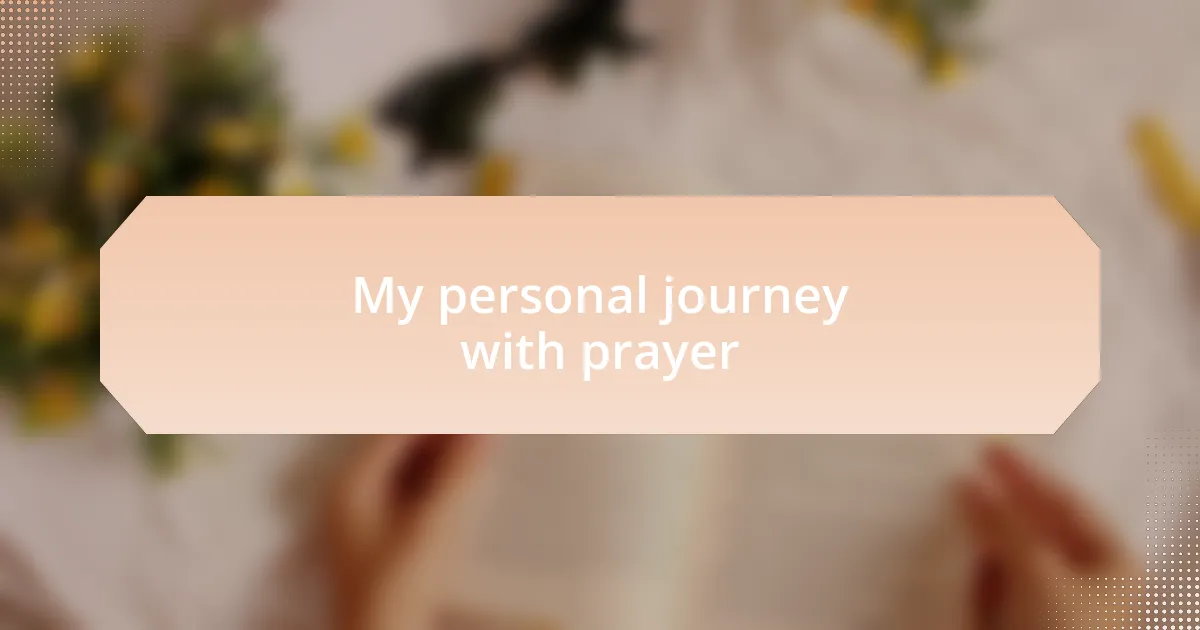
My personal journey with prayer
There was a time when I found myself overwhelmed by life’s demands, and I turned to prayer almost as an experiment. I started with just a simple request for peace, thinking it was a means to an end. But as I engaged sincerely, I realized it became a two-way conversation—a space to express both my longings and my gratitude, which shifted my perspective in unexpected ways.
Notably, there was one evening when I sat in silence, eyes closed, and felt a wave of warmth engulf me as I prayed. It was as if the worries that had attached themselves to my shoulders were gently lifted, and in that moment, I understood prayer not just as an act of speaking but as a form of listening. Have you ever pondered how simply taking time to listen can unlock the answers you need? This experience taught me that prayer isn’t just about finding words; it’s about cultivating a heart open to receiving peace.
Throughout my journey, I discovered that prayer can transform mundane moments into sacred rituals. I made it a habit to pray while walking, feeling connected to the world around me as I spoke my intentions aloud. Each step became a mantra, and I often wondered: how could something so simple bring such depth to my life? By merging movement with prayer, I unearthed a unique tranquility, solidifying my belief that peace can be found in the rhythm of everyday life.
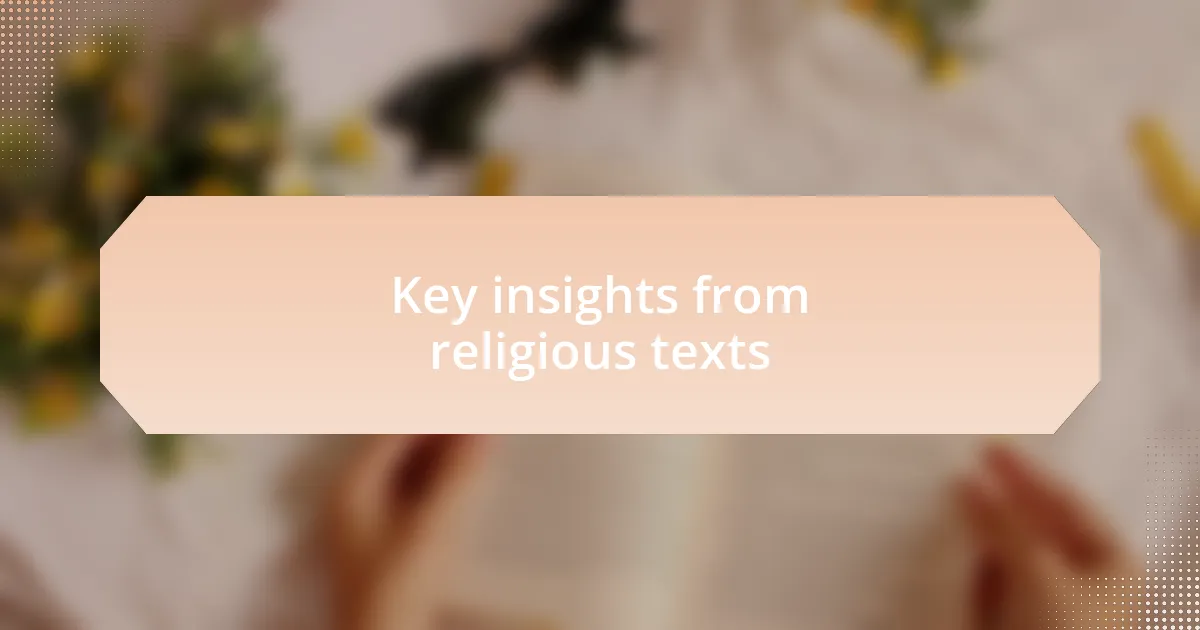
Key insights from religious texts
Religious texts often illuminate the profound connection between prayer and peace, highlighting how ancient wisdom remains relevant. For instance, in the Psalms, we see a recurring theme of finding solace in surrendering worries to a higher power. This insight resonates with my experience—have you ever felt the weight of uncertainty lift as you entrusted your concerns to something greater than yourself? It’s a powerful reminder that we’re not alone in our struggles.
From the Quran, the idea that prayer is a form of remembrance—“Indeed, in the remembrance of Allah do hearts find rest” (Quran 13:28)—strikes a chord with me. When I reflect on this, I recall moments when, even amidst chaos, stopping to pray allowed me to ground myself and anchor my thoughts. It’s fascinating how a simple act of remembrance can create a sanctuary within, isn’t it? This connection between reminding ourselves of the divine and finding inner peace is a key insight that lingers with me.
Furthermore, Buddhist texts emphasize mindfulness in prayer, suggesting that being fully present can enhance our experience. I remember a particularly hectic day when I chose to focus solely on my breath during prayer, letting each inhale and exhale draw me deeper into a state of calm. It was a practice that transformed how I approached prayer—it became less about the words and more about the experience. Isn’t it intriguing how sometimes, letting go of expectations can open the door to unexpected tranquility?
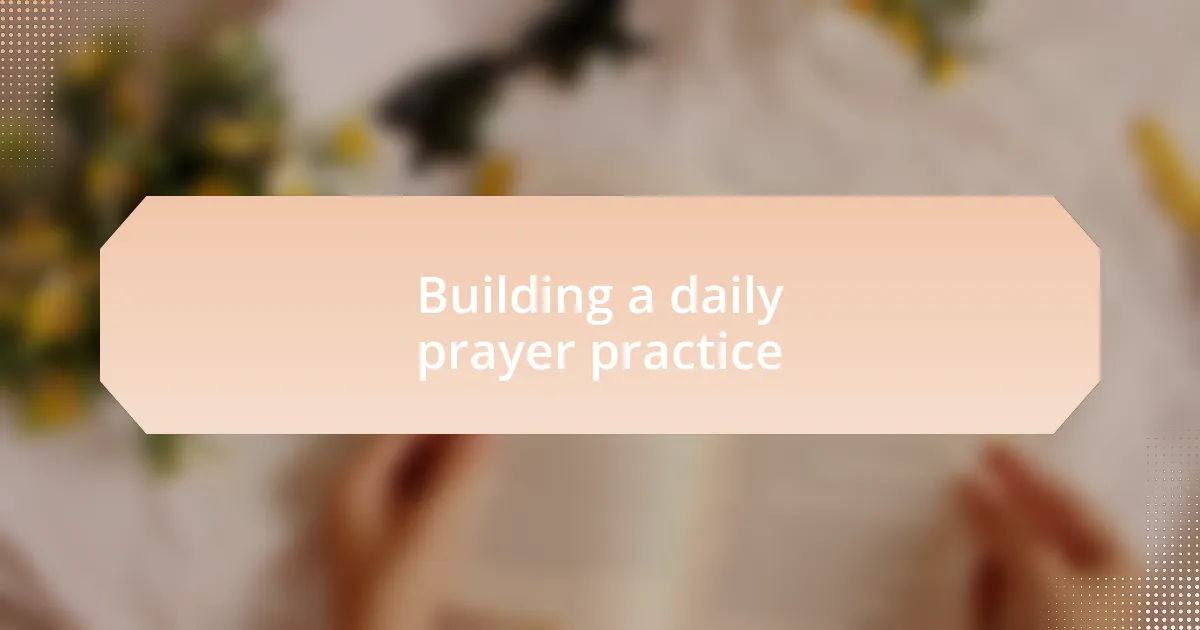
Building a daily prayer practice
Establishing a daily prayer practice can be a transformative journey. I remember the first time I committed to praying every morning before the day took over. At first, it felt awkward, like I was forcing myself into a routine that didn’t quite stick. Over time, however, I began to look forward to those moments of solitude, realizing that they set a peaceful tone for my day. Have you ever noticed how carving out just a few minutes for quiet reflection can make a difference in your mindset?
To build a consistent habit, I found it helpful to create a dedicated space for prayer. My small corner, adorned with a candle and a few meaningful mementos, became my sanctuary. In this space, I felt more connected—not just to my spirituality but also to myself. It’s fascinating how the environment can influence our spiritual practice, don’t you think? Whenever I sit there, it feels like an invitation to reconnect, grounding me in ways that words alone sometimes cannot express.
Moreover, integrating variety into my prayer practice has enriched my experience immensely. Some days, I pray aloud; other times, I write down my thoughts, letting pen to paper be a form of dialogue with the divine. Once, during a particularly tough week, writing my feelings down became a revelation. It was as though my worries, once tangled in my mind, found clarity on the page. This adaptability keeps the practice fresh and engaging, inviting a deeper connection every time I step into that sacred space. How do you keep your prayer practice vibrant?